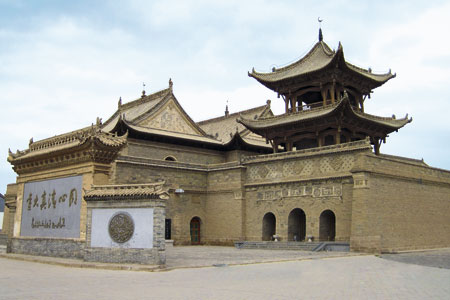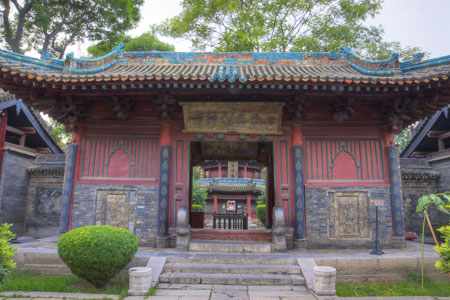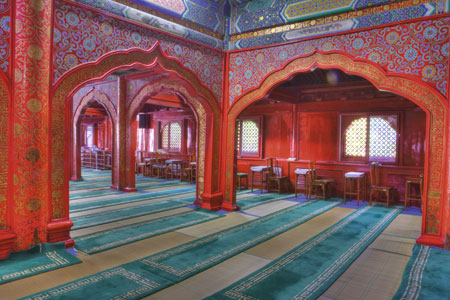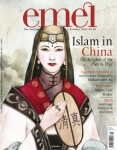
Sacred Houses of Worship - Mosques in China
Issue 73 October 2010
Eighty years after the hijrah, Pagoda-style mosques emerged in China. Ethar El-Katatney explores four of the 45,000 mosques in China.
My first sight of a Chinese mosque literally took my breath away. To come across something so different and yet so familiar, so beautiful and so stunning, brought tears to the eyes of many of my fellow travellers.
There are approximately 45,000 mosques in China. Some, mostly in Western China, follow the traditional mosque style - tall minarets, arches and domes. But in Eastern China, the majority don’t, seeing minarets as foreign to their culture. Instead, they fuse together Islamic and Chinese architecture.
Chinese Muslim architecture began by imitating the sacred religion that came before Islam, in this case Tibetan Buddhism; and by respecting the sacred architecture of the temples around them whilst making their mosques uniquely Islamic.
In Chinese architecture, symmetry is very important, and the Chinese mosques follow that style. Likewise, landscapes are sacralised through the creation of asymmetrical gardens, built to allow the visitor to meander through.
On the outside, the majority of the mosques are built in pagoda style - tiered towers with multiple flared protruding eaves. Ancient Chinese tradition believes that cubes represent the earth and circles represent the sky - as such, some Chinese Muslims believe the Ka’ba as a cube represents the earth, in union with the sky above it. And so pagodas are the norm for Chinese mosques. Colours are also symbolic, red for the earth and blue for the sky, the former usually on the arches of the mosque and the latter on the ceiling.
Walk inside a mosque and the Chinese-Islamic presence is immediately felt: prayer timings in Arabic and Chinese, reed prayer mats, tablets and vases with Arabic calligraphy, a mimbar and mihrab, a Chinese imam making du’a in Arabic, Qur’ans in Chinese and Arabic, and walled courtyards with incense burners.
If you take the summation of Chinese architecture as a whole, you will realise in the Islamic context that you are really able to see its beauty, since without statues one can really focus on intricate simplicity.
Depending on the area of China you are in, the number, size and beauty of the mosques differ. But everywhere you go, you will encounter the same mosque-goers: men with snowy white beards, women with serene faces, and children with ready smiles.
The overall impact of the mosques is momentous, illustrating Islam’s capacity for expressing unity in diversity.
Tong Xin Great Mosque
Portrait by Yang Guiping

Built in the early period of the Ming dynasty (from 1368), the Tong Xin mosque is a key relic of the country. The mosque was built with a combined style of traditional Chinese architecture, with an Islamic influence in its woodwork and brick carving. The mosque in its entirety is five-room wide and nine-room deep, with a pavilion style construction in front of the service hall.
The Grand Mosque of Xian
Portraits by Shahbaz Anwar & Saima Akhtar

Built in the Tang dynasty in the 7th century, it is said to be one of the first mosques in China. Located in the middle of the Muslim Quarter in Xian, where over 70,000 Muslims live, it is an oasis of tranquility.
To get to the prayer hall, I had to walk through a sprawling complex of lush gardens filled with cobblestone pathways and pools of water lilies to the background of birds chirping. The mosque grounds, covering an area of over 13,000m2, were built with the aim of allowing the worshipper to empty his mind of worldly distractions. There are five main courtyards, each with a signature pavilion and old stone archways inscribed with both Chinese and Arabic lettering: “May the religion of the Pure and Real spread wisdom throughout the land” and “The mosques are the markets of the afterlife.”
In the centre courtyard, you come across the Pavilion for Introspection, with a 10-metre brick tower that serves as a minaret. Three stories high, the tower’s eaves are decorated with blue glazed tiles and carved dragonheads.
The ceiling of the magnificent prayer hall, covering an area of 1,270m2, is covered with the names of God written in patterns of flowers. But it is the walls that are truly breathtaking: wooden boards engraved with the entire Qur’an - in both Arabic and Chinese.

The painted wooded mihrab is in a special enclave, surrounded by detailed and intricate Qur’anic inscriptions. Imbedded in a pool of lotus, the inscriptions are simultaneously Chinese and Islamic.
Beautiful and serene, the Xian Mosque receives tens of thousands of visitors each year. Every day 100 – 200 people pray here. In Ramadan, between five and six hundred pray tarawih.
Niujie Mosque
Portrait by Shahbaz Anwar

There are 200,000 Muslims in Beijing, and a tenth of them centered in the Niujie district – the highlight of which is one of the ancient mosques in China. At 1,014 years old, covering nearly 10,000 square metres, it has 11 imams, and is visited by more than 200 people every day. On Friday, nearly a thousand worshippers attend congregational prayer.
There are 72 mosques in Beijing, but none comes remotely close to the beauty of the Niujie mosque. Split up into male and female ablution rooms and prayer areas, there are numerous courtyards and gardens throughout, a Qur’an school and several halls for classes and other events. There are two shaykhs buried in the complex who had come to China 700 years ago to teach Islam, and their graves are honoured with carved tablets.
Outside the prayer area is the ‘Watching Moon Tower,’ a magnificent hexagonal, two-storied pagoda painted in reds, blues and greens. It was so named because it was used by the imam to sight the moon in order to determine the start of Ramadan.
Inside the prayer hall, you are greeted with a riot of colours - rich maroon archways with yellow inscriptions, and blue ceiling beams decorated with intricate designs and paintings of gardens, trees and flowers - no humans or animals. Master calligraphy of Qur’anic passages line the archways, and huge circular tablets are hung on the walls. Chinese lanterns, glass beads and coloured glass adorn the corners of the mosque, and a sign with ‘Allah’ on it hangs above the mimbar - near which a wooden stick stands to commemorate the stick the Prophet Muhammad used when he preached.
The mihrab is inlaid with wooden and bronze carvings, and was brought over from Yemen 1,000 years ago. Inscribed with verses of the Qur’an, it occupies a special place in the hearts of the worshippers.
The Huaisheng Mosque
Portrait by Cherie Wendelken*

*1984, Courtesy of the Aga kHAN visual archive, MIT
Also known as the Lighthouse Mosque, it is the main mosque of Guangzhou, and was originally built 1,300 years ago, making it one, if not the first mosque in China. It is said to have been built by Sa’d ibn Abi Waqqas, an uncle of the Prophet Muhammad.
Fusing Chinese and Arab architecture, the mosque complex covers an area of about 3,000m2. Through a number of gates, you come across a tower with a plaque in Chinese on it that reads “Religion that holds in great esteem the teachings brought from the Western Region.” The prayer hall is surprisingly plain, with one distinctive Qur’anic inscription above the mihrab.
But it is the freestanding brick minaret that is the mosque’s most distinctive feature. Thirty six metres high, capped with a small dome on a thin turret, it is cylindrical with two internal stairways, and the balcony is thought to have been a beacon to boats.
There are six main buildings in the complex: the Imam’s Quarters, the Wangyue Attic, the Covered Corridor, the Storehouse of Islamic Scripture, the Stone Steles Pavilion and the Light Tower.
Bookmark this |
|
Add to DIGG |
|
Add to del.icio.us |
|
Stumble this |
|
Share on Facebook |
|
Share this |
|
Send to a Friend |
|
Link to this |
|
Printer Friendly |
|
Print in plain text |
|


Comments
1 Comment
1
SARA
23 Oct 10, 22:53
excellent islamic history revealing devoted chinese muslims